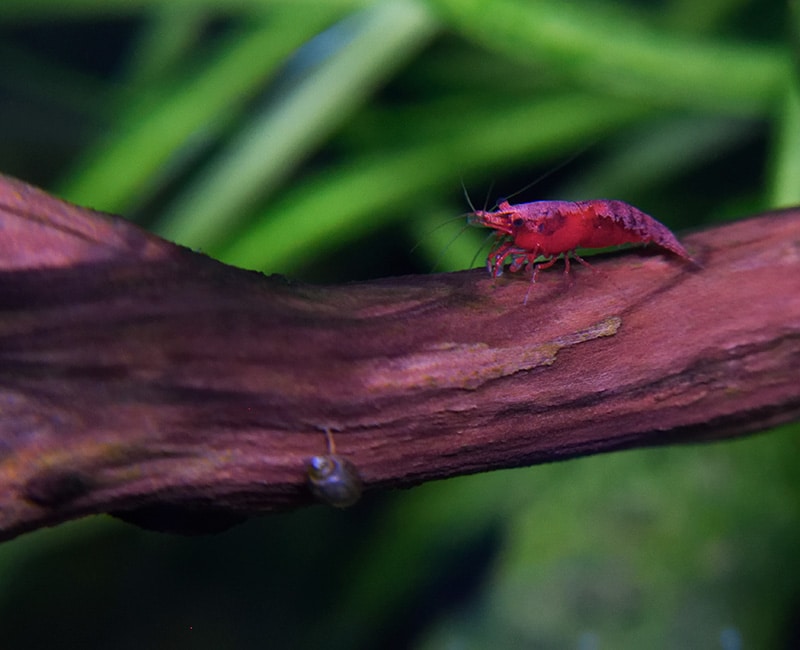Shrimply Explained is currently undergoing renovations. Please don't buy anything yet. Thank you!
Well, just like race cars, the back stripe on cherry shrimp is there to make shrimp look cool as we zoom around the tank. That’s why the marking is commonly called a “racing stripe”. You may even hear us yelling “VROOM VROOM @$!#%!!” because that makes us go faster. We—Uh oh, I gotta go.

Ugh, sorry everyone. It’s so hard keeping Shrimply away from the keyboard. He loves trying to create content for you but has trouble staying on topic.
Let’s start from the beginning.
A back stripe on cherry shrimp, and any other Neocaridina, is a completely normal genetic variation. (Cherry shrimp and Neocaridina will be used interchangeably in this text)
As Shrimply mentioned, this trait is commonly called a “racing stripe” because it resembles the stripes seen on race cars and the vehicles of drivers who don’t obey traffic laws. Certain breeds of Neocaridina, like yellow goldenbacks, are actually defined by this back stripe. Back stripes are always lighter hues of the underlying color, so yellow Neocaridina have a yellow-tinted back stripe, cherry shrimp have a red-tinted back stripe, etc.
Here are some common questions about shrimp back stripes and answers to them:
Back stripes may appear at any time as your shrimp mature, although they do not typically show up until at least 2 months of age. As Neocaridina get older, this back stripe becomes more pronounced and covers more of their shell.
Very little research has been done on Neocaridina so we do not know exactly why the back stripe develops when it does or why it changes. While it certainly has a genetic basis, there may be environmental conditions that affect the back stripe as well.
The back stripe changes after each molt so, while it normally gets larger with age, the back stripe can also become smaller or even disappear for a few molts.
It is a common misconception that only females can get a back stripe. Male Neocaridina can also develop a back stripe, although they do not seem to have them as often.

Yes! Any traits that vary between individuals can be bred for and the back stripe is no different. Various hobbyists have had success with breeding Neocaridina that have a back stripe covering almost all their shell—In fact, it can hardly be called a back stripe at that point. Somewhat surprisingly, we have never seen these back stripe-enhanced individuals for sale but they look very cool and may become available in the future.
Since it is a genetic trait, it will be passed on to any offspring from that individual. If you like the look of the back stripe and want to keep it in your shrimp population, then great - just leave those shrimp in your tank.
If you don't like the aesthetic of shrimp with a back stripe, then it is best to remove the shrimp with that trait to avoid giving it to future generations. It may still pop up simply due to genetic variation in your population, but it will not affect most individuals
Sure, as long as it is done humanely (shrimpmanely?). While the assumption is that the racing stripe does not confer any particular benefits, there haven't been experiments to prove it so maybe those shrimp are actually faster. Probably not though.
The back stripe found in Neocaridina is one of many interesting genetic variations in shrimp populations. Because traits like color and pattern vary between individuals, sometimes even day-to-day, you never know what new appearances you might encounter when looking into a shrimp tank. It's part of why we love this hobby.
Still have questions about back stripes, or anything else shrimp-related? Fantastic! Please reach out via email or social media and ask it. We love speaking with curious members of the community to share and learn together.
Have a Shrimply beautiful day,
Pssst... Want to learn everything you need to know to have happy and healthy freshwater shrimp? We've got you covered with clear, concise, and fun information in every lesson of The Shrimp School!
You know it's true because we have a badge.
Other Shrimp Content
We have a lot of new content coming soon. Please follow us on social media and subscribe to our newsletter for updates and useful shrimp care tips!